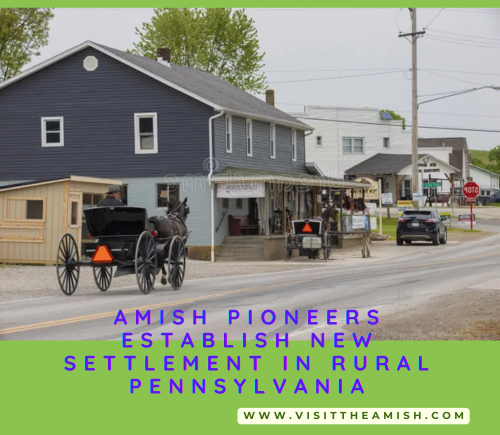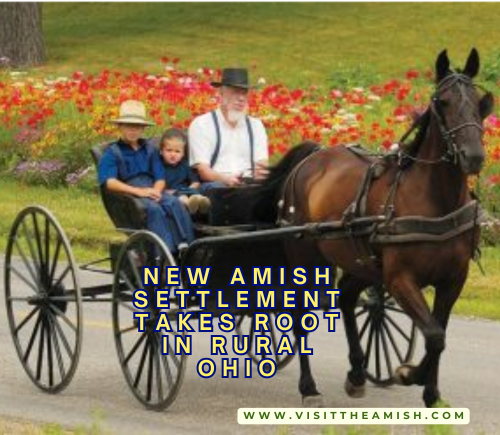Buggies and Barns: Inside Maine’s Thriving Amish Frontier
In the far reaches of northern Maine, where the rolling hills of Aroostook County meet the Canadian border, an unexpected revival is taking place. The Amish community in Fort Fairfield and neighboring Easton, once a tentative experiment, has blossomed into a thriving settlement that’s breathing new life into the region’s agricultural heritage.
As the sun rises over the frost-kissed fields on a crisp December morning, the clip-clop of horse hooves echoes along Forest Avenue. Noah Yoder, 49, adjusts his wide-brimmed hat as he guides his buggy towards the family’s dairy barn. It’s been over 16 years since Noah, his wife Lovina, and their 11 children first arrived in this corner of Maine, pioneers in what would become a transformative Amish migration.
“When we came here in August 2007, it was just us,” Noah recalls, his eyes crinkling with a mixture of pride and nostalgia. “Some communities start and fail. We still could. But by God’s grace, we’ve grown.”
Grown indeed. What began with the Yoders has expanded to include over 30 families, totaling approximately 140 people. The settlement now boasts seven dairy farms, two schoolhouses, an Amish-run store, and a successful sheet metal business. It’s a far cry from the abandoned Johnson farm the Yoders first settled, where they planted plum trees from Noah’s father’s orchard in Ohio – a symbolic bridge between their past and future.
The journey to Fort Fairfield wasn’t a decision made lightly. Noah spent two years searching for the ideal location to establish a new community. “What drew us to the area was the beautiful scenery, availability of farmland, and some of the nicest people we’ve ever met,” he explains. “We’ve been well-accepted here and appreciate that.”
The Yoders’ story is not unique. Families have migrated from across the Midwest, including Ohio, Iowa, and Missouri, each bringing their own skills and determination. Uri Hochstetler, 35, moved from Kentucky with dreams of starting a dairy farm. “In Kentucky, I was a farrier who’d never driven a buggy through a blizzard or cut ice from a frozen pond,” Uri chuckles. “Now, I’m milking twenty cows by hand every day.”
The Amish settlers in Fort Fairfield are known as Swartzentruber Amish, one of the most traditional groups. Their commitment to simplicity is evident in every aspect of their lives. Homes are lit by oil lamps instead of propane, and businesses that require power use diesel engines driving line shafts and belts, as electricity from the grid is not permitted.
This adherence to tradition, however, hasn’t hindered their economic impact. In fact, it’s become a draw for tourists and locals alike. Sarah Thompson, who runs the general store in nearby Chesterhill, has noticed the change. “It’s been quite a sight to see horse-drawn buggies on our roads again,” she remarks. “They’re breathing new life into some of the old farms around here.”
The Amish influence extends beyond agriculture. Several families have opened woodworking shops, producing handcrafted furniture that’s gaining popularity in nearby towns and even as far as Bangor. Others have established produce stands along Route 377, offering fresh vegetables, homemade jams, and baked goods that have become local favorites.
Perhaps most significantly, six Amish farms have joined the Agri-Mark dairy cooperative, makers of Cabot cheese. Twice a day, Amish farmers like Uri Hochstetler milk their cows by hand into stainless steel buckets, which are then strained and delivered by buggy to one of two milking houses. This integration into the broader agricultural economy has helped stabilize milk prices for all local dairy farmers.
The settlement’s growth hasn’t been without challenges. The county has had to install new road signs warning drivers about slow-moving vehicles, and some residents are still adjusting to sharing the roads with horse-drawn buggies. Local authorities have also navigated zoning issues to accommodate the Amish’s traditional building practices.
Education, a cornerstone of Amish life, has also taken root in Fort Fairfield. The community has established two one-room schoolhouses, currently educating a total of 47 children. Mary Hochstetler, 22, one of the community’s teachers, emphasizes their educational philosophy: “We’re teaching our children the importance of hard work and simplicity, while also ensuring they have the skills to interact with the outside world when necessary.”
What sets the Fort Fairfield settlement apart is its youthful energy. Only three residents are over 50 years old, giving the community a dynamic and forward-looking perspective. This youth-driven vitality has been a boon for the local area, revitalizing agricultural lands that had long lain fallow.
County Commissioner John Hawkins sees the Amish influx as a positive development. “These families bring a strong work ethic and a commitment to rural living. It’s exactly what our community needs,” he states. “We’ve seen a 15% increase in agricultural output in just the past six months.”
The Amish settlement’s success has not gone unnoticed. It’s part of a broader trend of Amish expansion in Maine, which began with the state’s first Amish community in Smyrna in 1996. That settlement has since spun off “sister” communities in Unity and Hodgdon. The Fort Fairfield Amish, while maintaining connections with these other settlements, have carved out their own unique niche in Aroostook County.
As the sun sets over the Aroostook River, casting long shadows across the patchwork of fields and forests, Noah Yoder reflects on the past decade. “We came here seeking a place where our children could continue our way of life, with room for farms and small businesses,” he says. “What we’ve found is not just land, but a true home.”
The Amish revival in Fort Fairfield is more than just a demographic shift; it’s a living experiment in community building, rural preservation, and maintaining a traditional way of life in the 21st century. As Noah puts it, “We’re not just preserving our past, we’re cultivating a future – one that honors God, family, and the land.”
Looking ahead, the community has plans for further expansion. Eli Yoder, Noah’s nephew who arrived from Geauga County, Ohio, with his wife and seven children, is optimistic about the future. “We’re planning to open a harness shop next spring, which will serve both Amish and English customers,” he shares. There are also discussions about establishing a sawmill and a bulk food store, further cementing the Amish presence in the local economy.
The impact of the Amish settlement extends beyond its immediate borders. Local real estate agent Tom Brennan reports increased interest in properties near the Amish community. “People are drawn to the idea of living near a community that values simplicity and hard work,” he explains. “It’s creating a unique cultural dynamic in our area.”
This cultural exchange goes both ways. While the Amish maintain their distinct lifestyle, they’ve also embraced certain aspects of their new home. Many families have taken up maple syrup production, a quintessential Maine tradition, integrating it into their agricultural practices.
The settlement’s success has also attracted attention from other Amish communities across the country. “We’ve had visitors from Pennsylvania, Ohio, and Indiana, all curious about our experience here,” Noah Yoder notes. “Some are considering starting their own settlements in Maine.”
As the Fort Fairfield Amish community celebrates its 16th year, it stands as a testament to the enduring appeal of a simpler way of life. In an age of rapid technological change and urban sprawl, this corner of Maine offers a glimpse into an alternative path – one that values community, tradition, and a deep connection to the land.
The plum trees Noah Yoder planted when he first arrived are now bearing fruit, both literally and metaphorically. As he looks out over the thriving farms and bustling workshops, he sees not just the fulfillment of a personal dream, but the birth of a legacy. “We came here to build something that would last,” he says, a smile crinkling the corners of his eyes. “God willing, our grandchildren and great-grandchildren will still be farming this land long after we’re gone.”
In the quiet farmlands of Aroostook County, amidst the clip-clop of horse hooves and the lowing of cattle, a remarkable transformation continues. The Amish settlement in Fort Fairfield and Easton stands as a living bridge between past and future, a community that has not just survived, but thrived, bringing with it a renewed sense of purpose and possibility to this far-flung corner of Maine.
Citations:
[1] https://amishamerica.com/2024-amish-population-passes-four-hundred-thousand/
[2] https://amishamerica.com/pennsylvania-amish/
[3] https://downeast.com/features/thesettlers/
[4] https://groups.etown.edu/amishstudies/twelve-largest-settlements-2024/
[5] https://www.transportation.ohio.gov/wps/wcm/connect/gov/b3b86275-f673-4a2b-b4ae-69a58f82c194/AmishPopulationTrends.pdf?MOD=AJPERES&CONVERT_TO=url&CACHEID=ROOTWORKSPACE.Z18_K9I401S01H7F40QBNJU3SO1F56-b3b86275-f673-4a2b-b4ae-69a58f82c194-nAkqhqh
[6] https://www.timesunion.com/news/article/Amish-enclave-moves-to-Washington-County-16411219.php
[7] https://groups.etown.edu/amishstudies/amish-population-profile-2024/
[8] https://www.witf.org/2019/08/26/a-squeeze-and-a-vision-why-some-amish-want-to-leave-lancaster-county/
[9] https://www.ideastream.org/2024-05-28/your-new-neighbors-may-drive-a-buggy-ohios-amish-population-is-growing
Like this:
Like Loading...


















